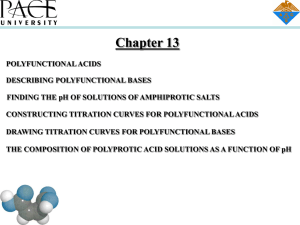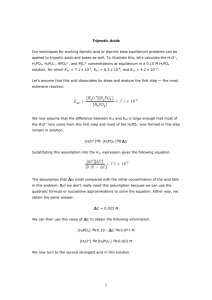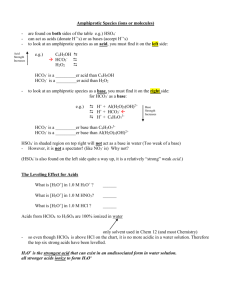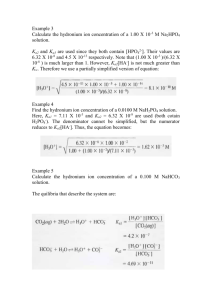Chapter 13
advertisement
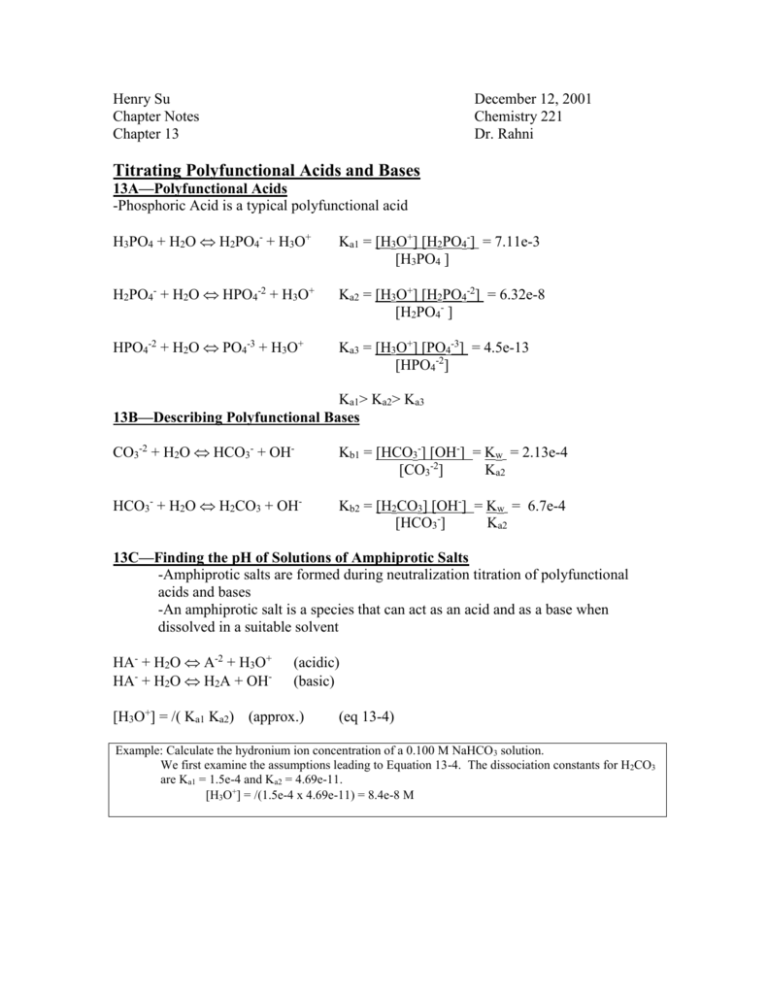
Henry Su Chapter Notes Chapter 13 December 12, 2001 Chemistry 221 Dr. Rahni Titrating Polyfunctional Acids and Bases 13A—Polyfunctional Acids -Phosphoric Acid is a typical polyfunctional acid H3PO4 + H2O H2PO4- + H3O+ Ka1 = [H3O+] [H2PO4-] = 7.11e-3 [H3PO4 ] H2PO4- + H2O HPO4-2 + H3O+ Ka2 = [H3O+] [H2PO4-2] = 6.32e-8 [H2PO4- ] HPO4-2 + H2O PO4-3 + H3O+ Ka3 = [H3O+] [PO4-3] = 4.5e-13 [HPO4-2] Ka1> Ka2> Ka3 13B—Describing Polyfunctional Bases CO3-2 + H2O HCO3- + OH- Kb1 = [HCO3-] [OH-] = Kw = 2.13e-4 [CO3-2] Ka2 HCO3- + H2O H2CO3 + OH- Kb2 = [H2CO3] [OH-] = Kw = 6.7e-4 [HCO3-] Ka2 13C—Finding the pH of Solutions of Amphiprotic Salts -Amphiprotic salts are formed during neutralization titration of polyfunctional acids and bases -An amphiprotic salt is a species that can act as an acid and as a base when dissolved in a suitable solvent HA- + H2O A-2 + H3O+ HA- + H2O H2A + OH- (acidic) (basic) [H3O+] = ( Ka1 Ka2) (approx.) (eq 13-4) Example: Calculate the hydronium ion concentration of a 0.100 M NaHCO 3 solution. We first examine the assumptions leading to Equation 13-4. The dissociation constants for H2CO3 are Ka1 = 1.5e-4 and Ka2 = 4.69e-11. [H3O+] = (1.5e-4 x 4.69e-11) = 8.4e-8 M 13D—Constructing Titration Curves for Polyfunctional Acids -Compounds with two or more acid functional groups yield multiple endpoints in a titration, provided the functional groups differ sufficiently in strengths as acids. -Included in a titration curve for a weak diprotic acid and strong base are the following: 1-Initial pH -Initially, only the first dissociation makes an appreciable contribution to [H3O+] 2-First Buffer Region -The addition of minimal base results in the formation of a buffer consisting of the weak acid H2M and its conjugate base HM-. The solution can be treated as a simple buffer system. 3-First Equivalence Point 4-Second Buffer Region -Further additions of base to the solution create a new buffer system consisting of HM- and M-2. 5-Second Equivalence Point 6-pH Beyond the Second Equivalence Point -pH is determined by the concentration of the excess OH13E—Drawing Titration Curves for Polyfunctional Bases -The construction of a titration curve for a polyfunctional base is pretty much the same issue as with a polyfunctional acid, only with a negative slope, like a 180° horizontally flipped polyfunctional acid titration curve. 13F—The Composition of Polyprotic Acid Solutions as a Function of pH -Alpha values can be calculated for polyfunctional acids and bases in the following equation: 0= [H2M] ct ct = [H2M] + [HM-] + [M-2] 1 = [HM-] ct 2 = [M-2] ct 0 + 1 + 2 = 1 (sum of alpha values must equal unity) -Note that the denominator is the same for each expression. Note also that the fractional amount of each species is fixed at any pH and is independent of the total concentration ct.

